The AMD Trinity Review (A10-4600M): A New Hope
by Jarred Walton on May 15, 2012 12:00 AM ESTAMD Trinity: Battery Life Also Improved
With all of the changes going into Trinity, one thing that hasn’t changed since Llano is the process technology. Trinity is once again coming on a 32nm process from GlobalFoundries. If we were talking about Intel, Trinity would represent a “Tock” on the roadmap—a new architecture on an existing process. We’ve looked at CPU and GPU performance, and this is a part that’s pretty much universally faster than its predecessor. Given the lengthier pipeline and Bulldozer-derived architecture, I admit that I was concerned Trinity might actually be a step back for battery life; it appears that my fears were unfounded, largely due to the improvements in Piledriver. As usual, we tested with all laptops set to 100 nits brightness in our idle, Internet, and H.264 playback tests. I also ran some additional tests which we’ll discuss in a moment. First, here are the standard battery life results:
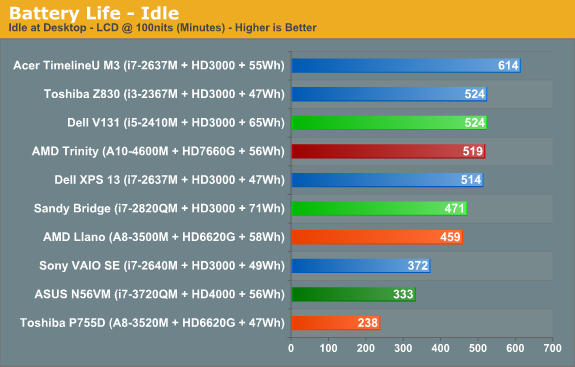
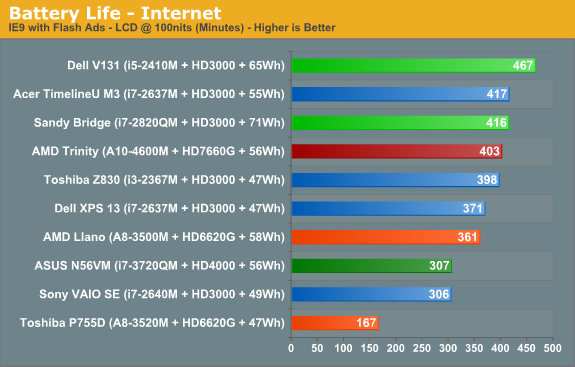
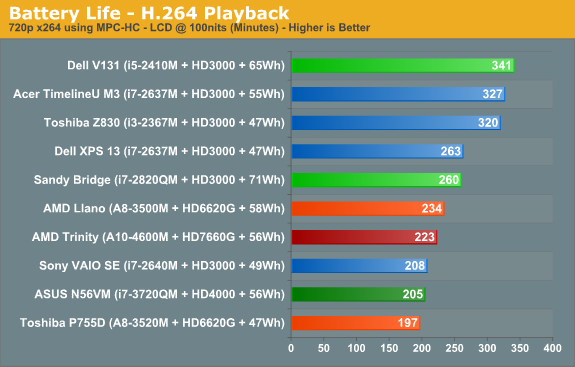
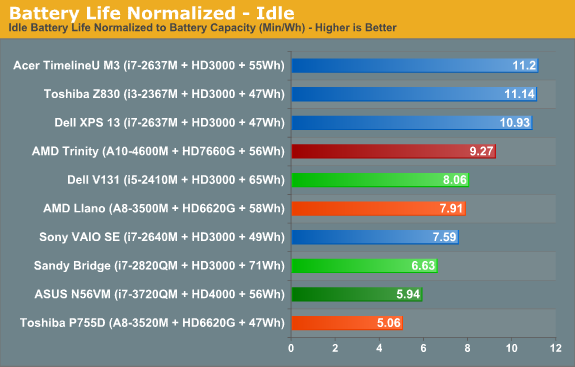

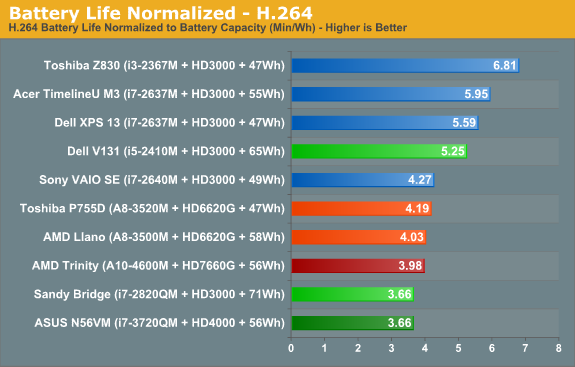
With a similar capacity battery to the original Llano laptop, and the same size 14” panel, Trinity comes out of the gates and posts two clear wins: idle battery life and Internet battery life are both up substantially relative to Llano. In fact, looking at the normalized charts, the only laptops that can consistently beat Trinity are found in Sandy Bridge ultrabooks—we won’t even bother discussing Atom or Brazos netbooks, as they’re competing in a completely different performance bracket. In something of a surprise, H.264 battery life doesn’t see the same benefit unfortunately, and it’s the one discipline where Llano still holds on to a slight lead over Trinity. Sandy Bridge meanwhile has always done very well in H.264 battery tests, and we see that with the Vostro V131 posting a normalized score that’s 30% better than Trinity and Llano. Of course, on the other end of the spectrum we have Ivy Bridge; we’ve only looked at one Ivy Bridge laptop so far, but if the pattern holds than Ivy Bridge will generally be a moderate step back in battery life relative to Sandy Bridge, giving AMD an even larger lead in this area.
We also performed a few other tests that we won’t present in graph form. One set of tests we alluded to earlier: the charts show Trinity with a Samsung 830 SSD, but we also ran tests with an Intel 520 SSD. Idle battery life dropped to 476 minutes (an 8% decrease), Internet battery life checked in at 371 minutes (down 8% again), and H.264 battery life stayed nearly the same at 217 minutes (down less than 3%). If battery life is one of your primary concerns, remember: all SSDs are not created equal!
Another test that we ran is simulated gaming; we looped the four graphics tests in 3DMark06 at 1366x768 until the battery ran out. We’ve run this same test on quite a few other laptops, and Llano initially looked to be far and away the best solution. Later, we discovered that when we tested Llano we were letting the GPU run in power saving mode—basically half the performance you’d get compared to being plugged in. We retested and measured 98 minutes, so the extra graphics performance comes with a heavy cost. We only tested Trinity (and Ivy Bridge and Sandy Bridge) using higher performance graphics settings, and this is one more area where it scores worse than Llano: Trinity managed just 77 minutes. That’s about the same as Ivy Bridge and Sandy Bridge (79 and 73 minutes, respectively), so if you’re after better gaming performance while running off the mains, you might need to keep looking.
Before getting too carried away with the above results, you still need to consider how important battery life is for your usage model. Some people travel a lot and like to go all day without plugging in; others will go from place to place and plug in whenever they’re not on the go. If you fall in the latter category, battery life isn’t usually a problem with any decent laptop, while those looking for all-day computing will definitely want as much mobility as possible. Ultimately, battery life is a factor of battery capacity as well as power optimizations done by the OEMs. We’ve seen battery life improve by as much as 50% when comparing two otherwise similar notebooks, but at least AMD’s reference platform for Trinity delivers a great starting point.
Temperatures and Acoustics
One other item we wanted to quickly touch on is system temperatures. We typically use HWMonitor and check temperatures of laptops under idle and load conditions. We did this with Trinity as well, but unfortunately the current version of HWMonitor doesn’t give us a lot of information. The only temperatures it reports are from the SSD and the HD 7660G graphics—there’s nothing about CPU core temperatures. That means we can’t provide much detail, other than to say that load temperature on the GPU topped out at 71C during extended testing, while the idle temperature was 39C. As usual, temperatures and noise levels go hand in hand, and the low 71C maximum GPU temperature matches up nicely with noise levels that never got above 37dB. It’s not the quietest laptop we’ve ever tested, and surface temperatures can get a little warm, but overall Trinity looks to be a good balance of performance and power requirements, which means quiet laptops are definitely possible.










271 Comments
View All Comments
duploxxx - Tuesday, May 15, 2012 - link
if you want a more responsive laptop then buy an SSD, no one needs a laptop like the recent released Intel QC that turbo up all the way to 3.xxx whalhalle GHZ... its disc performance that is lacking most.jabber - Tuesday, May 15, 2012 - link
Exactly.My main laptop that I use most of the day is a 1.3Ghz CULV dual core from Intel. It does everything I need as a roving PC engineer. It benches the same as an old PentiumD 2.8Ghz.
If I put a SSD in it (which I want to) then I'd probably struggle to tell it apart day to day from one with a i5 cpu in it. CPU makes no difference to me.
Since dual cores came out in 2005/6 customers dont notice CPU upgrades all that much. You put a SSD in though and they notice that. Oh and if they can play WoW or Sims with the trimmings then they love that too.
Once again is it possible to add the latest Sims game to the benchmarks list? I dont play it myself but nearly every teens laptop I get has it on and I do get asked about good laptops for such a game.
BSMonitor - Tuesday, May 15, 2012 - link
Roving PC engineer? You mean you go to meetings and look at Word Documents. That hardly makes you the "average" user. The rest of us do the actual work.Spunjji - Wednesday, May 16, 2012 - link
Look up the meaning of the word average.CeriseCogburn - Thursday, May 24, 2012 - link
I'll monitor this one - since really old cpu's are way more than enough grunt since the trinity cpu sucks so badly and amd needs another gigantic hand of endless applause and praise by many frenetic amd fans flavoring up the place, we have learned one thing -All the old laptops are just fine. If you have a discrete of any sort, just use that. Add a little cheap ram, or add an SSD and it will beat trinity no problem all the time.
I thank all the trinity lovers for the hot tip - no one needs a trinity laptop.
BSMonitor - Tuesday, May 15, 2012 - link
Not for facebooking and trolling no. But I do real work on my PC.Spunjji - Tuesday, May 15, 2012 - link
Name the part of their CPU performance that doesn't meet the "good enough" metric. Seriously, convince me of your argument. So far it sounds like the usual crap I hear from people who don't understand the average user's needs.BSMonitor - Tuesday, May 15, 2012 - link
And you speak for "average" user like you know 100 million business users. I work in an IT shop. It took years of convincing to get off our P4's to Core2Duo. Because management takes the "good enough" stance like you. Waiting for email client base on JAVA runtime is NOT acceptable. Having Adobe reader pages lag when browsing them, re-sizing, is NOT acceptable. It STILL lags behind my Core i7 machine at home. And is VERY noticeable.Again, ebay, FB, yahoo... These are not the majority of users who care about performance.
In regards to 14 y/o's and housewives, yes, trinity rules. But then so did those laptops from 6 years ago. For them.
sumguy+4 - Tuesday, May 15, 2012 - link
So you are claiming that Intel's performance has improved by only 20% over the past 6 years??!?The article's summary stated that Trinity's CPU deficit vs Intel is 20-25% (while being cheaper and offering better video perf)
Show us the mobile CPU from 6 years ago that could even come close.
juampavalverde - Tuesday, May 15, 2012 - link
Wait... youre using and email client? haha... and its based on java? LOL!. And youre using adobe reader? ROTFL!A great part of the performance comes using software that gets all the juice from the hardware you have, there is no need even in the newest systems to use so bloated software.
By the way, i have an old HP 6910p with a C2D and 2 GB DDR2, GM965, it kicks butt and im thinking to throw a cheap SSD on it because is good enough to do any task i need to do (office apps, web apps, remote connections).